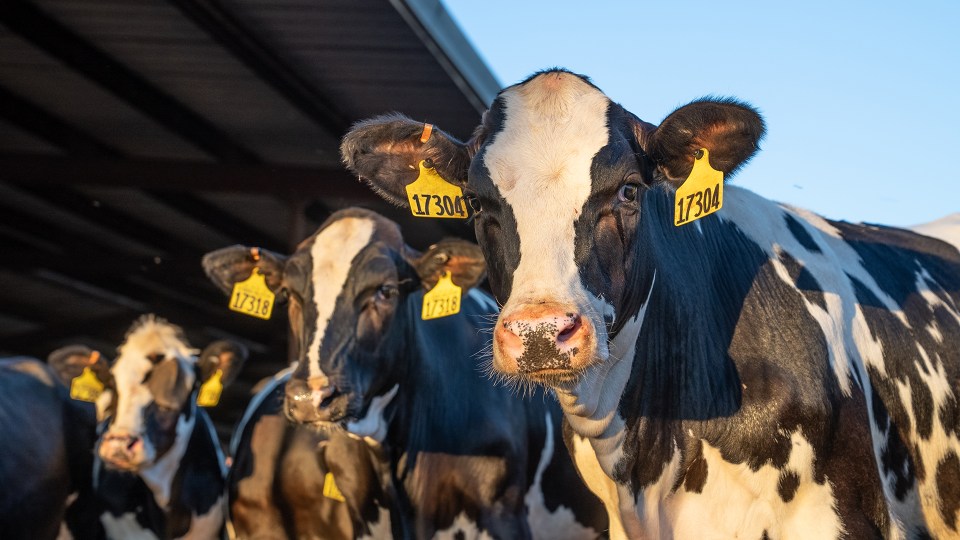Do not overlook deworming for heifers on pasture
By Dr. Lowell T. Midla
If your replacement heifers are grazing on pasture this summer, don’t overlook the importance of deworming.
Monitoring for internal parasites and removing them when present helps heifers get the nutrients they need to grow and develop at the proper rate. Treating heifers with an effective dewormer ensures animals are parasite-free when they enter the milking string or move back into confinement in the fall.
Parasite-free heifers convert feed more efficiently, have fewer disease problems, and have more efficient reproduction.1 Follow these five key principles for effective parasite control in dairy heifers:

1. Test feces for internal parasites.
Don’t guess whether internal parasites are present or not. Instead, use a fecal egg count (FEC) to determine if deworming is needed. FECs are both inexpensive and easy to perform.
Female worms inside the digestive tract of the animal lay eggs, which are passed in the feces. A FEC examines a fecal sample under a microscope to determine the number of eggs present.
For dairy heifers entering their first lactation, and particularly for those that are entering confinement (that is, no longer grazing pasture), any FEC result above zero means that adult worms are present. Deworming at this time is almost always recommended.
Ideally, the deworming treatment should be followed up with a Fecal Egg Count Reduction Test (FECRT). See details under “Measure your deworming success” below.
2. Find the best times to deworm.
When heifers come off grazing to enter confinement, it’s a great opportunity to deworm because they won’t be on pasture again and re-exposed to parasites. Both grazed and non-grazed heifers should be dewormed just prior to entering the milking string.
Keep in mind that any time adult cows are exposed to pasture, they likely should be dewormed when they re-enter confinement. Pasture-based grazing dairies should work with their veterinarian to develop a parasite control strategy.
3. Choose effective dewormers.
Dewormers in the benzimidazole and macrocyclic lactone classes are the most widely utilized for cattle. Macrocyclic lactones are available as pour-on or injectable forms, while benzimidazoles are typically administered orally.
To keep existing dewormers effective and keep resistance to a minimum, dairy producers using a dewormer that ends in “-ectin” should consider adding another product where the active ingredient ends in “-zole,” such as SAFE-GUARD® (fenbendazole).
SAFE-GUARD is a member of the benzimidazole class of dewormers and is proven effective in the face of parasite resistance – making it a powerful choice to use as part of a strategic deworming protocol.2 It is safe to use in pregnant animals and can be used at any stage of lactation or gestation.
Accurate dosing is critical – not only to give the anthelmintic the best chance of working effectively, but also to help reduce development of resistance. When animals are dosed based on the average weight of the group, approximately 50% of the animals will always be underdosed. Ideally, animals should be weighed. When this is not possible, the weight of each animal should be estimated individually and the correct dose of dewormer administered.
In an operation where heifers are grazing throughout the summer, feed formulations of SAFE-GUARD – including pellets, cubes, free-choice mineral and liquid – are easy and highly effective ways to deworm.
4. Measure deworming success.
The only way to determine the effectiveness of your deworming program is through a Fecal Egg Count Reduction Test (FECRT). The FECRT protocol consists of taking samples from the group of interest on the day of treatment and then sampling from the same group again 14 days after treatment.
Pretreatment and posttreatment samples are sent to the same lab and tested to determine fecal egg count reduction. Ideally, 20 pre- and post- samples are taken. It is not necessary that the samples come from the same animals. An absolute minimum of eight samples is necessary to ensure that the conclusions drawn from the results are likely to be correct.3
Successful deworming should result in a 95% or greater reduction in parasite eggs in feces. At minimum, a 90% or greater reduction should occur if the dewormer is effective.4 If the result is below 90%, the reason why should be investigated with the help of your veterinarian.
If improper dosing is ruled out, resistance could be at play – which means it’s time to change your protocol. Ask your Merck Animal Health representative for a free FECRT kit.
For more than a decade, Merck Animal Health has maintained the world’s largest FECRT database to monitor field-use efficacy of dewormers approved for use in cattle in the U.S. According to the FECRT database, endectocide pour-on and injectable products are performing well below the 90% FEC reduction threshold. Endectocide pour-on products show only a 51% efficacy with almost half the eggs remaining 14 days after pour-on application. Adding SAFE-GUARD achieved 99.1% effectiveness.
5. Monitor for parasites regularly.
Work with your veterinarian to set up an internal parasite control program that works best for your operation. You may decide that FEC testing every six months is necessary, but it should certainly be no less than once a year.
If your veterinarian recommends strategic deworming based on your heifers’ exposure to pasture, be sure to incorporate FECRT testing annually to measure the effectiveness of your program. Learn more at SafeGuardWorks.com.
SAFE-GUARD IMPORTANT SAFETY INFORMATION:
Do not use in beef calves less than 2 months old, dairy calves and veal calves. A withdrawal period has not been established for this product in pre-ruminating calves. Additionally, the following meat withdrawal and milk discard times apply:
SAFE-GUARD Paste: Cattle must not be slaughtered for 8 days. For dairy cattle, the milk discard time is 96 hours.
SAFE-GUARD Suspension: Cattle must not be slaughtered for 8 days. For dairy cattle, the milk discard time is 48 hours.
SAFE-GUARD Type A and other medicated feed products (pellets, cubes, free-choice mineral, or free-choice liquid): Cattle must not be slaughtered for 13 days. For dairy cattle, the milk discard time is 60 hours.
References
- Mejía M, Perri A, Miglierina M, Formía N, et. al. Effect of anthelmintics on reproductive performance and first-lactation culling rate in Holstein heifers. The Veterinary record, 165(25), 743–746 (2009).
- Kaplan R, Denwood M, Nielsen M, Thamsborg S, et al. World Association for the Advancement of Veterinary Parasitology (W.A.A.V.P.) guideline for diagnosing anthelmintic resistance using the faecal egg count reduction test in ruminants, horses and swine. Veterinary parasitology, 318, 109936 (2023). Advance online publication. https://doi.org/10.1016/j.vetpar.2023.109936.
- Dobson R, Jackson R, Levecke B, Besier B, et al. Guidelines for fecal egg count reduction tests (FECRT). World Association for the Advancement of Veterinary Parasitology (WAAVP) (2001) Proceedings: 23rd International Conference of the World.
Find more content for your dairy operation.
About the author

Lowell T. Midla
V.M.D., M.S.,
Dairy Technical Services,
Merck Animal Health
